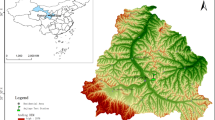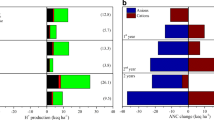Abstract
Fertilization of wheat (Triticum aestivum, L.) residue applied to degraded soils has shown promise as an option to restoring soil organic C (SOC) stocks, but the impact of the practice on N2O and CH4 emissions is not clear. It was hypothesized that, in addition to the mulch-induced soil wetness conditions favorable for N2O and CH4 formation, emission of these gases will be stimulated due to increased availability of mineral N and interference of NH4 + with CH4 oxidation in soils. During the period February–November 2000, fluxes of N2O and CH4 were monitored in a plant-free central Ohio Crosby soil (fine, mixed, mesic Aeric Ochraqualf) amended for 4 years with wheat straw (bare, 0; low, 8 Mg ha–1 year–1; and high, 16 Mg ha–1 year–1) without and with N fertilization (244 kg N ha–1). The average annual N2O fluxes were 1.1 kg N2O-N ha–1 in the unfertilized and 4.1 kg N2O-N ha–1 in the fertilized treatments. Annual N2O emission (Y, mg N2O-N m–2) was strongly correlated to the maximum daily flux (X, mg N2O-N m–2 day–1; Y=48.3X−58.1, R 2=0.85, P<0.001) recorded on experimental plots. These flux maxima occurred at spring thaw in the unfertilized, and 6–30 days after fertilization in the fertilized treatments. Net CH4 uptakes were measured on some occasions; overall, however, all the treatments were net CH4 emitters with annual rates of 3.6, 4.9 and 5.1 kg CH4-C ha–1 in the bare, low and high residue treatments, respectively. No significant effect of fertilization and mulch rate on CH4 fluxes was found, but temperature and landscape position appeared as strong controllers. Regardless of treatments, the highest CH4-emitting plots were located in a minor depressional area at the experimental site. A comparison of SOC gain and N2O and CH4 emission expressed as CO2-equivalents indicates that the residue treatments have a net CO2-mitigating effect, but since C sequestration rates are expected to decrease with time, that positive effect will likely vanish after 7 and 12 more years in the fertilized and unfertilized residue treatments, respectively.




Similar content being viewed by others
References
Akala VA, Lal R (2001) Soil organic pools and sequestration rates in reclaimed minesoils in Ohio. J Environ Qual 30:2098–2104
Bayer C, Mielniczuk J, Amado TJC, Martin-Neto L, Fernandes SV (2000) Organic matter storage in a sandy clay loam Acrisol affected by tillage and cropping systems in southern Brazil. Soil Till Res 54:101-109
Bedard C, Knowles R (1989) Physiology, biochemistry and specific inhibitors of CH4, NH4 + and CO oxidation by methanotrophs and nitrifiers. Microbiol Rev 53:68-84
Bouwman AF (1996) Direct emission of nitrous oxide from agricultural soils. Nutr Cycl Agroecosyst 46:53-70
Chin KJ, Conrad R (1995) Intermediary metabolism in methanogenic paddy soil and the influence of temperature. FEMS Microbiol Ecol 18:85-102
Devevre OC, Horwath WR (2000) Decomposition of rice straw and microbial carbon use efficiency under different soil temperatures and moistures. Soil Biol Biochem 32:1773-1785
Duiker SW, Lal R (1999) Crop residue and tillage effects on carbon sequestration in a Luvisol in central Ohio. Soil Till Res 52:73-81
Hanson RS, Hanson TE (1996) Methanotrophic bacteria. Microbiol Rev 60:439-476
Horwath WR, Paul EA, Harris D, Norton J, Jagger L, Horton KA (1996) Defining a realistic control for the chloroform fumigation-incubation method using microscopic counting and 14C-substrates. Can J Soil Sci 76:459-467
Houghton JT, Meira Filho LG, Callander BA, Harris N, Kattenberg A, Maskell K (eds) (1996) Climate change 1995 — the science of climate change. Contribution of Working Group I to the second assessment report of the Intergovernmental Panel on Climate Change. Cambridge University Press, Cambridge
Hütsch BW, Webster CP, Powlson DS (1994) Methane oxidation in soil as affected by land use, soil pH and N fertilization. Soil Biol Biochem 26:1613-1622
IPCC (1997) Revised 1996 IPCC guidelines for national greenhouse gas inventories, reference manual, vol 3. Cambridge University Press, Cambridge
Jacinthe PA, Dick WA (1997) Soil management and nitrous oxide emissions from cultivated fields in Southern Ohio. Soil Till Res 41:221–235
Jacinthe PA, Lal R, Kimble JM (2002a) Annual carbon budget and seasonal carbon dioxide emission from mulch-covered soils. Soil Till Res 67:147–57
Jacinthe PA, Lal R, Kimble JM (2002b) Effects of wheat residue fertilization on accumulation and biochemical attributes of organic carbon in a central Ohio Luvisol. Soil Sci 167:750–758
Lal R (1997) Residue management, conservation tillage and soil restoration for mitigating greenhouse effect by CO2-enrichment. Soil Till Res 43:81-107
Littell RC (1989) Statistical analysis of experiments with repeated measurements. Hortiscience 24:37–40
Luo J, Tillman RW, White RE, Ball PR (1998) Variation in denitrification activity with soil depth under pasture. Soil Biol Biochem 30:897-903
Mosier A, Schimel D, Valentine D, Bronson K, Parton W (1991) Methane and nitrous oxide fluxes in native, fertilized and cultivated grasslands. Nature 350:330–332
Nusslein B, Conrad R (2000) Methane production in eutrophic Lake Plusssee: seasonal change, temperature effect and metabolic processes in the profundal sediment. Arch Hydrobiol 149:597-623
Parsons WFJ, Mitre ME, Keller M, Reiners WA (1993) Nitrate limitation of N2O production and denitrification from tropical pasture and rain-forest soils. Biogeochemistry 22:179-193
Pol van den-van Dasselaar A, van Beusichem ML, Oenema O (1998) Effects of soil moisture content and temperature on methane uptake by grasslands on sandy soils. Plant Soil 204:213-222
Priemé A, Christensen S, Dobbie KE, Smith KA (1997) Slow increase in rate of methane oxidation in soils with time following land use change from arable agriculture to woodland. Soil Biol Biochem 29:1269-1273
Reicosky DC, Kemper WD, Langdale GW, Douglas CL, Rasmussen PE (1995) Soil organic matter changes resulting from tillage and biomass production. J Soil Water Conserv 50:253-261
Robertson GP, Paul EA, Harwood RR (2000) Greenhouse gases in intensive agriculture: contributions of individual gases to the radiative forcing of the atmosphere. Science 289:1922-1925
SAS Institute (1990) SAS/STAT User's Guide, version 6, 4th edn. Sas Institute, Cary, N.C.
Schulz S, Conrad R (1996) Influence of temperature on pathways to methane production in the permanently cold profundal sediment of Lake Constance. FEMS Microbiol Ecol 20:1-14
Scott A, Ball BC, Crichton IJ, Aitken MN (2000) Nitrous oxide and carbon dioxide emissions from grassland amended with sewage sludge. Soil Use Manage 16:36-41
Smith KA (1997) The potential for feedback effects induced by global warming on emissions of nitrous oxide by soils. Global Change Biol 3:327–338
Tabatabai MA (1982) Soil enzymes. In: Page AL, Miller RH, Kenney D (eds) Methods of soil analysis. Part 2. Chemical and microbiological properties. American Society of Agronomy, Madison, Wis., pp 903–947
Watson RT, Meira-Filho LG, Sanhueza E, Janetos A (1992) Greenhouse gases: sources and sinks. In: Houghton JT, Callander BA, Varney SK (eds) Climate Change 1992: the supplementary report to the IPCC scientific assessment. Cambridge University Press, Cambridge, pp 25–46
Acknowledgement
The authors gratefully acknowledge the technical support provided by Dr J. M. Kimble of the NSSC of NRCS at Lincoln, Nebraska.
Author information
Authors and Affiliations
Corresponding author
Rights and permissions
About this article
Cite this article
Jacinthe, PA., Lal, R. Nitrogen fertilization of wheat residue affecting nitrous oxide and methane emission from a central Ohio Luvisol. Biol Fertil Soils 37, 338–347 (2003). https://doi.org/10.1007/s00374-003-0607-4
Received:
Accepted:
Published:
Issue Date:
DOI: https://doi.org/10.1007/s00374-003-0607-4




